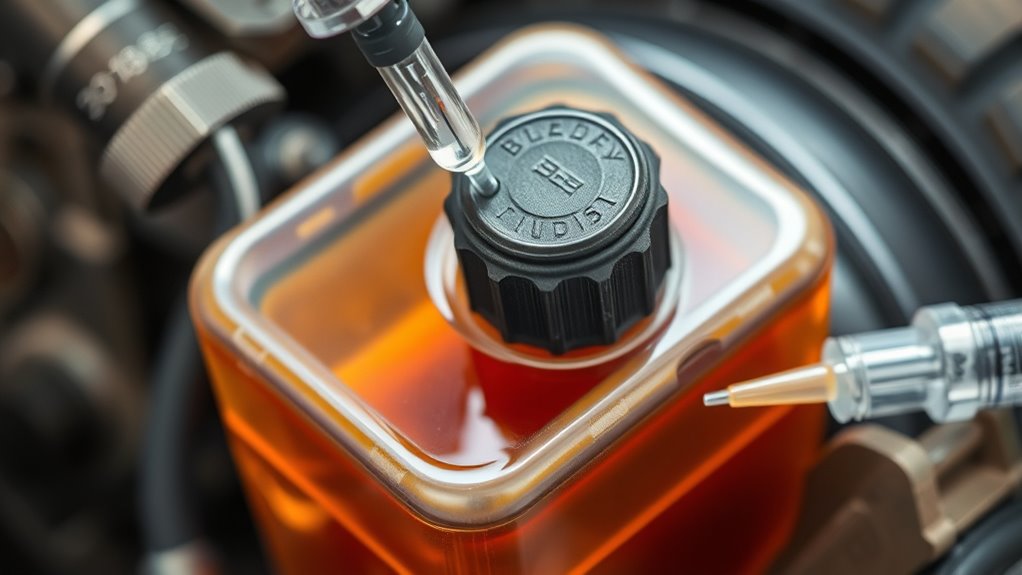Choosing the right brake fluid, like DOT 3, DOT 4, or DOT 5, is vital for your vehicle’s braking performance and compatibility. To bleed your brakes, start at the furthest wheel from the master cylinder, have an assistant press the pedal, open the bleed screw, then close it before releasing the pedal. Keep the fluid reservoir topped up and follow proper steps to remove air and guarantee safety. Continue exploring to learn detailed procedures and tips for maximum brake maintenance.
Key Takeaways
- Use the vehicle manufacturer’s recommended brake fluid type, such as DOT 3, DOT 4, or DOT 5.
- Regularly inspect and replace brake fluid to prevent contamination and moisture buildup.
- Begin bleeding at the farthest wheel from the master cylinder, typically passenger rear.
- Open the bleed screw, have an assistant press the brake pedal, then close the screw before pedal release.
- Ensure the brake fluid reservoir remains topped up during bleeding to prevent air entry into the system.

Choosing the right brake fluid and knowing how to properly bleed your brakes are essential steps to maintaining your vehicle’s stopping power. Brake fluid is crucial because it transmits force from the brake pedal to the brake calipers or wheel cylinders, enabling you to stop safely. Using the correct type of brake fluid for your vehicle ensures peak performance and prevents damage to your braking system.
Choosing the right brake fluid is essential for safe, effective braking performance.
Most vehicles specify a particular brake fluid in the owner’s manual, commonly DOT 3, DOT 4, or DOT 5. DOT 3 and DOT 4 are glycol-based fluids that are compatible with most standard brake systems, while DOT 5 is silicone-based and typically reserved for classic cars or specialized applications. Mixing different types of brake fluid can cause chemical reactions that compromise brake performance, so always adhere to the manufacturer’s recommendations.
When choosing brake fluid, check the color and specifications on the bottle to confirm compatibility. Properly maintaining your brake fluid involves regular checks for contamination or moisture, which can diminish braking effectiveness and lead to corrosion within the system. Additionally, understanding the importance of a proper bleed procedure ensures your brakes function reliably and safely.
Knowing how to bleed your brakes is equally crucial, especially if you’ve performed repairs, replaced brake components, or noticed a soft or spongy brake pedal. Air can get trapped in the brake lines during maintenance, which diminishes braking power. Bleeding removes this air, restoring proper pedal feel and stopping ability.
To bleed your brakes, start with the vehicle on a flat surface and ensure the engine is off. You’ll need a few basic tools, including a clear tube, a wrench, and fresh brake fluid. Begin at the wheel farthest from the master cylinder, usually the passenger rear, then proceed diagonally to the driver rear, passenger front, and finally the driver front.
Open the bleed screw slightly, have an assistant press the brake pedal, then close the screw before the pedal is released. Repeat this process until you see clear, bubble-free brake fluid flowing through the tube. Be sure to keep the master cylinder reservoir topped up during the procedure to prevent air from entering the system.
If you’re unsure about the process, consult your vehicle’s manual or seek professional help, as improper bleeding can lead to inadequate braking or damage.
Frequently Asked Questions
How Often Should Brake Fluid Be Replaced?
You should replace your brake fluid every 2 to 3 years or every 30,000 to 45,000 miles, whichever comes first.
Regularly checking the fluid’s color and level helps you gauge its condition. When it looks dark or contaminated, it’s time for a flush.
Keep in mind, fresh brake fluid maintains proper brake performance and prevents corrosion in your braking system, ensuring safety on the road.
Can I Mix Different Brake Fluid Types?
Mixing different brake fluid types isn’t recommended, as it can cause chemical reactions that compromise braking performance.
Did you know that even a small mix-up can reduce brake fluid’s boiling point by up to 50%?
You should always use the manufacturer’s specified brake fluid to guarantee safety.
If you accidentally mix types, flush the system completely and refill with the correct fluid to maintain ideal braking efficiency.
What Safety Precautions Are Necessary During Bleeding?
You should wear protective gloves and safety goggles to prevent contact with brake fluid, which is corrosive. Work in a well-ventilated area to avoid inhaling fumes.
Keep a container nearby to catch old fluid and avoid spills. Never let the brake fluid reservoir run dry, as air can enter the system.
Finally, dispose of used fluid responsibly, following local regulations. These precautions keep you safe and ensure a proper bleed.
How Do I Identify a Brake Fluid Leak?
A brake fluid leak is like finding a puddle in your driveway—you’ll notice fluid pooling under your vehicle or around brake components.
Check the master cylinder, brake lines, calipers, and wheel cylinders for wetness or dark, greasy spots.
Feel for a spongy brake pedal or reduced braking performance.
If you spot any signs, address the leak promptly to prevent brake failure and guarantee your safety on the road.
What Tools Are Essential for Bleeding Brakes?
You’ll need a few essential tools to bleed your brakes effectively. Grab a clear plastic hose, a catch container, and a wrench to fit the bleeder valves.
A brake bleeder kit can simplify the process with a pump or vacuum system.
Don’t forget to have fresh brake fluid on hand.
These tools help you remove air bubbles and guarantee your brake system works smoothly and safely.
Conclusion
Understanding the right brake fluid type and proper bleeding procedures guarantees your vehicle’s braking system stays reliable. Did you know that using the wrong fluid can reduce braking efficiency by up to 50%? Regularly checking and bleeding your brakes can prevent costly repairs and keep you safe on the road. Stay proactive with maintenance, and your brakes will perform smoothly when you need them most. Remember, a small investment in upkeep goes a long way!









